Surfski.info Review: Think Uno
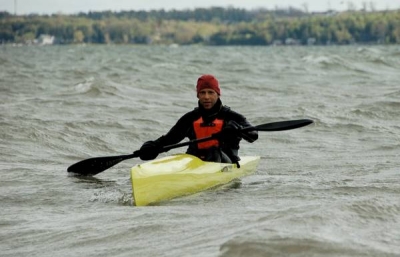 Think Uno
Think Uno
I finally got my hands on one of the new Think Unos this spring. Because Wisconsin is sort of in the middle of nowhere relative to the commercial transport routes, it seemed like I was about the last person in the world to actually lay my eyes on the ski and I had to bear with the initial reports coming in from Australia, Washington, Rhode Island and elsewhere.
Finally, I took delivery of the ski, unwrapped it, and . . . it was nighttime. But, like any other true paddler, I donned my basic paddling attire, snuck past my wife, who's eyes were fixed on "Dancing with the Stars" and her bowl of ice cream, and made it out of the house unseen for the initial test paddle. It was dark, air and water temps were the same - about 38 F (4 C). I did a 5 minute loop on placid water and then put the ski away. At least now I could get to sleep that night.
DESIGN
The Uno's shape is a bit unconventional. The first thing you will notice is that the hull has chines somewhat like on the Think Legend, only the chines are more subtle on the Uno. These "soft chines" start at about the paddler's knee and continue to just in front of the rudder. The hull shape between the chines is a very shallow arch. This shallow arch continues forwards almost to the bow which is also a bit different as well, because while many skis continue the V shape in the hull several feet back from the bow, the Uno hull becomes rounded quite early.
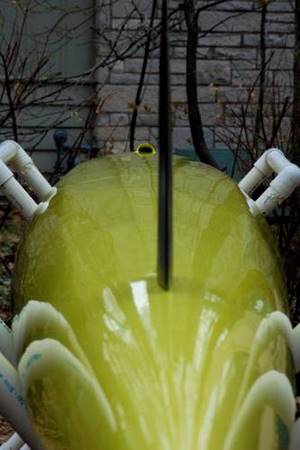
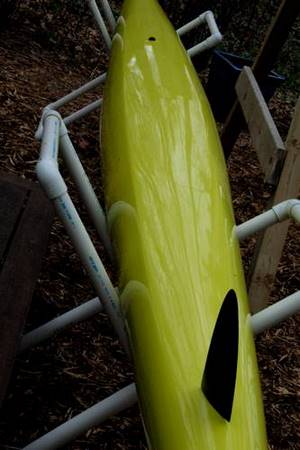
If viewed from the side, the Uno has a rather low bow height. If the bow is viewed from the seat or from in front of the ski, the bow has a dihedral shape which I surmise is similar to that of the new Red 7 Surf 70 Pro. The dihedral shape is like a diamond in cross section whereas the conventional bow cross sectional shape is more or less V with high, flat sides. What the dihedral design does is lessen the exposure to beam winds and waves while maintaining a similar volume.

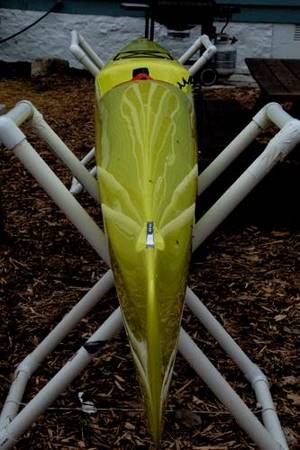
Much of the ski's volume is amidships, being just in front of the footwell and just behind the seat. In front of the paddler, the cross sectional volume is fairly high and shape is cylindrical. Right behind the paddler, the shape is more like a semi-circle with the maximum beam near the top of the deck. The stern is quite low in volume aft of the rudder and is pointed, i.e. not a transom style.
The bottom of the seat bucket is wide and I think this is possible because of the fact that the seat isn't dropped all the way down, essentially taking a mold off of the underlying hull as many other skis do to maximize stability at the expense of comfort for many paddlers. The back of the seat bucket and the shape of the bottom of the seat bucket tip the paddler upright and help avoid the slouch so unavoidable in many other skis.

The hump underneath the knees is low and the width here is narrow. On the seat / footwell hump is an attachment for a leash.
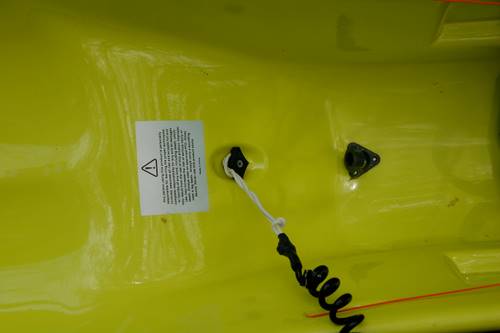
The footboard is micro-adjustable and feels very solid. Rudder lines run through pedal holes like in some other skis so that the pedals auto adjust when you move the position of the footboard. The conventional single footstrap has been replaced with dual footstraps - one for each foot. The footwell is slightly lower than the seat, and it feels like it. In front of the footboard is a well that appears smaller than usual. In front of the footwell is a screw port that gains access to the ski's interior. It is possible to put a fluid bladder down against the hull and run the tubing out through the hatch cover.
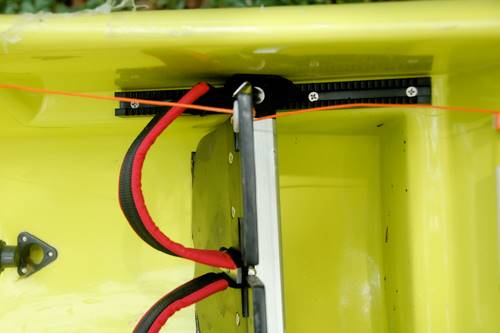
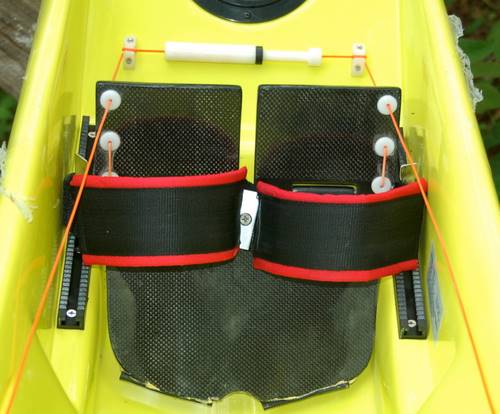
Bungees are supplied on the rear deck and held on by recessed anchors. There is another leash or rope attachment point on the aft deck in front of the rudder. I suppose that this could be used to meet European specs of having decklines. Engraved aluminum bow and stern handles are also of note, and look pretty slick. The handles could be used to tow the ski if the paddler has lost it (no leash). I think it would also be an possible method for a swimmer to get in or out through the surf by trailing or towing the ski, respectively.
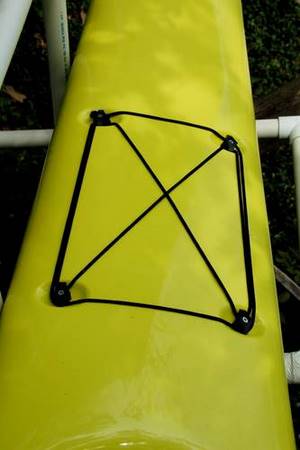

There is a single venturi hole in the rear part of the footwell complete with a cap that allows you to shut the venturi and thus keep water from filling up the footwell when you are moving slowly or not moving. It might be a nice option to use when you're doing intervals from a standing start and don't want to start each one with a footwell full of water. The venturi works very well and drains the low volume footwell very quickly.
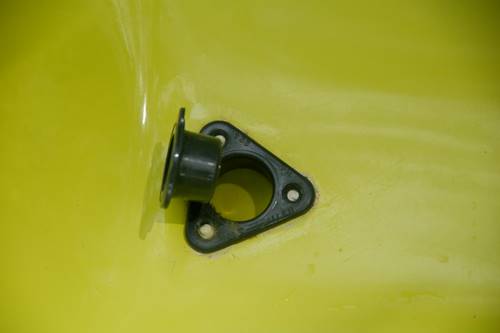
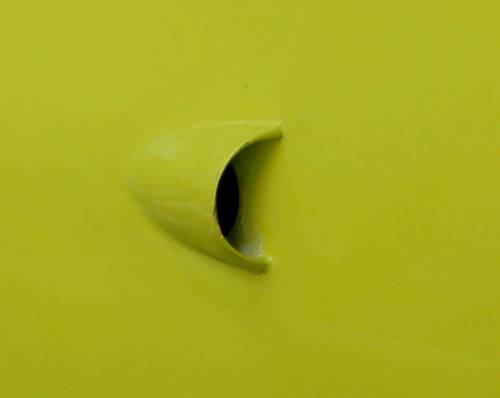
The gunwales are lower than on many other skis and this minimizes the chance of rapping your knuckles on them, lowers the volume of water that the swamped ski holds, and makes deep water reentry a bit easier. And reentry by the sidesaddle method feels easier than for the Fenn Elite which is the ski I practiced re-entries on most recently.
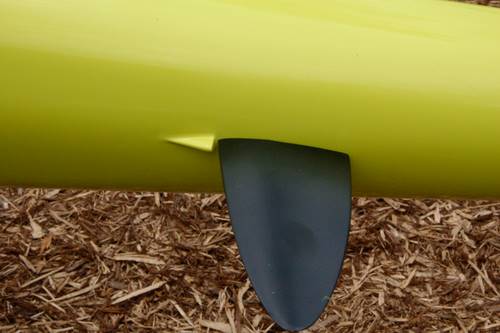
The rudder supplied with my Uno was an 8 inch high aspect model. The rudder is held on by a lock nut on top and a locator Allen screw at the back. The top lock nut keeps the rudder from dropping out and the Allen screw keeps the rudder aimed perpendicular to the crossbar - forwards. The rudder crossbar has three holes which can be used to tune the sensitivity of the steering, i.e. pedal lines attached to the outer holes for quick and responsive steering or attached to the inner holes for less responsive steering. The rudder shaft supplied with my Uno was slightly too small in diameter for the rudder tube so there was a slight amount of play in it. I remedied this with a wrap of aluminum tape. I also contacted Daryl Remmler about this and he said that he had already sourced larger diameter rudder posts that would be a more precise fit in the rudder tube. A weed guard is molded into the hull which is a nice touch.
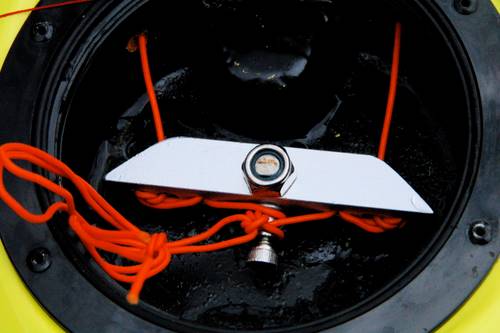
ON THE WATER
(For reference, I paddled a carbon Fenn Mako elite all last season and a carbon Fenn Mako 6 the season before that. Even before that, I used a carbon Fenn Millenium for a few years as my primary ski. To keep everyone on the same page concerning stability terms, I'll define primary stability as how twitchy the ski feels when trying to stay straight upright, secondary stability as - what is the tendency of the ski when you lean it about 30 degrees to the side, does it want to fall over, or come back upright?, and wave stability as how stable the ski feels in waves.)
The night that I slinked out of the house and tested the ski left me a bit concerned. It felt a bit tender. But, since it was in the dark and on near freezing water, I wasn't too concerned. The next morning, however, I went for an hour tour on flat water and it still felt a bit, shall we say, lively.
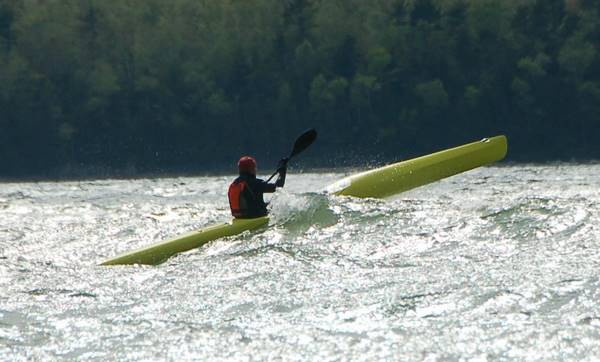
After many more hours in the Uno, I came to the conclusion that the ski isn't really unstable or unusually tippy as far as racing skis go. It's just got a different feel than other skis on the market. On flat water, the Uno feels a bit loose and lively and rolls a bit from side to side during the stroke. It took a few hours in the ski to become accustomed to the way it feels. I think what happens is that the ski gently rocks between the chines on the hull during normal paddling. At high speed, the primary stability doesn't really increase very much, unlike some other skis that become more stable the faster that they go. The Uno, on the other hand, simply stays loose and predictable and feels, as Daryl Remmler says, "like it's ready to pounce on something". And I agree, as it seems easy to accelerate.
Early on, I leaned the ski over to the side - and felt very little secondary stability. Later on, though, I found that the secondary stability is really there, it just comes in very late. You have to get the cockpit rim down to the water and then the aft deck, right behind the paddler, provides substantial secondary stability.
On one day, I had the pleasure of paddling for 30 minutes with 1-2 ft (.5 m) steep wind waves on my port beam, varying from being on full beam to quartering from the front and quartering from the stern. On the return trip, it was the same, only the waves were to starboard. The Uno seemed quite unaffected by these waves. It merely bobbed up and down and tended to stay straight upright through it all. Of course, I was pretty surprised with this because it's a pretty narrow ski. My guess is that the rounded and dihedral shape of the whole front of the ski deflects waves effectively and the lack of a pronounced V in the fore hull keeps the ski from digging in and being pushed around. I guess this makes sense if you think about a ski like a wheel barrow where you can vary the shape of the "wheel" out front (the stern is locked to a determined line by the rudder). If you push a V shaped bow across an undulating surface, it will catch at times or veer off at others. If the bow is rounded, it should glide over the surface relatively unaffected by waves. On the flip side regarding this design, however, is that the Uno does suffer some bow slap when going upwind in waves. Some paddlers don't like this, it doesn't bother me at all.
The 8 inch surf rudder which was supplied with my Uno is very responsive. Just a small movement of the rudder pedals from alternating leg drive made the ski turn and lean, more than I was used to. I partly remedied this by transferring the pedal lines from the standard outer holes to the middle holes on the rudder crossbar. That big rudder, though, makes the ski turn on a dime, and when doing so, you don't feel like you've let loose a parachute in the water (like the old Fenn Millenium rudder) as the ski still moves quite well. The 7 inch rudder feels predictably less responsive than the 8 inch, and more neutral, and in line with those from Fenn and Epic. The 5 inch rudder still works very well on waves and avoids broaching until very late.
Downwind, the Uno moves very well. But, honestly, most of the newer skis do too. It accelerates well, picks up runs easily, holds them well, doesn't feel sketchy at all when you're perched on top of a peak, nor when you've stalled in a trough. It also rides up and over smaller waves fairly easily.
I was out one day in 3-5 ft (1-1.5 m) steep wind waves generated by 18 hrs of 25-30 knot winds over 20 miles (32 km) of fresh water. Because the wind and waves were directly onshore, I did upwind / downwind loops for almost 2 hours. On these loops, I found that the Uno bow slaps a moderate amount going into the wind and waves. However, its low profile bow is virtually unaffected by the wind, so it's easy to turn upwind or hold any line off the wind that you would like to. At the top and bottom of each loop, when you are precariously turning across the wind and waves, the Uno feels really nice and stable. It doesn't get blown or leaned sideways like some other racing skis do. Downwind, the Uno accelerates very well, broaches very late, and is virtually unaffected by the pushy side waves so it yields a very smooth ride. I intentionally ran straight down some of the larger waves and noticed that the Uno buries its nose a bit more than other skis that have taller knife-like bows do, and the Uno's bow doesn't pop up right away but kind of stays buried for a few moments. This occurrence is avoidable most of the time if you just focus on becoming a better driver and veering off earlier.
COMFORT IS KING
I really like the Uno seat. It's more comfortable for me than any ski that I've tried to date. The other day I did a nonstop 4 hour training paddle and I wasn't even itching to get out of the ski at the end. And, believe it or not, I wasn't using any seat pads. Nothing. And, I've always needed seat pads in my skis. Of course, comfort is completely subjective. I'm a paddler with wide hips. I'm not very flexible. I really tend to slouch in Fenns and I get hip pinch if I don't sit on a seat pad in the Fenns, the V10's, and even the Synergy. The Uno's seat is deepest at the rear of the seat bucket, so it holds your ischial tuberosities back which tips your pelvis forwards. You therefore you don't find yourself pushing against the footboard every few minutes to re-gain a more upright posture. The back of the Uno's seat bucket is more vertical than the Fenns and V10, but not as vertical as that in the Icon and Mark 1.
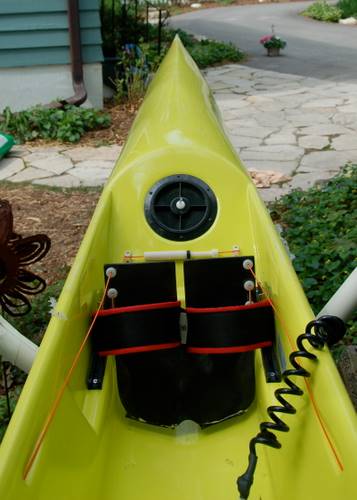
The hump under the knees is low and at my average size (5 ft 10 inches / 179 cm, 194 lbs / 88 kg), I'm nowhere near hitting the hump and my leg drive is not at all hindered.
HOW FAST IS IT?
Hull speed differences between the current crop of top racing skis is difficult to measure. 1 minute faster per hour is only 6 seconds faster every 6 minutes, which is what - three boat lengths? Can you measure that accurately? I really don't think so. Even when you do time trials in the same ski routinely, you'll see a wide variation in your own speed. Until we have a method of accurately measuring, not calculating, differences in hull-speed, I think we need to rely on subjective assessments and race results.
Take a look at the results from the recent Eurochallenge race in Spain. It was run on what was described as flat water with lots of boat wakes. Sean Rice and Tom Schilperoort both placed in the top 5 on Think Uno's ahead of seriously fast paddlers on Fenn Elites and Epic V12's. Logically, one can then conclude that the Uno is likely at least competitive with the current crop of top skis. My own sense of its speed is that it is a very fast hull comparative to the Fenn Elite. How the Fenn Elite compares to the Epics, Hukis, Icons, etc., I don't know, but my gut tells me that we're splitting hairs here. These are all fast skis. All I can say is that in training with my GPS during both sprints and long intervals, I'm seeing speeds on the Uno at least equal to what I saw with the Fenn Elite.

Click here for a larger version of this image.

Click here for a larger version of this image.

Click here for a larger version of this image.
PLUSES:
-
Comfort (obviously subjective) - the seat shape is masterful.
-
Hull speed - it accelerates extremely well on flat water and downwind and certainly feels as fast as my previous ski, a Fenn Elite.
-
Rough water handling - The deflecting dihedral bow and midships rounded volume renders the ski very predictable and neutral in confused seas.
-
Bow and stern handles, leash anchor, venturi cap
-
Finish is superb and comparable to Epic and Huki
-
Footstraps - While I initially didn't like the idea of dual footstraps, it makes sense and works well. The feet stay put and don't slide around on the footplate.
-
Low gunwales make for a better catch and easier capsize recovery.
-
Bow shape renders it impervious to crosswinds and waves.
MINUSUS:
-
Rudder shafts supplied with my prototype were slightly loose in the rudder tube and this caused some funky steering issues - this has already been corrected by the time of this article so it's a non-issue.
-
Rubbing is occurring between the bottom of the footboard and the footwell on my ski resulting in some gel coat being scuffed off after only a few hours of use. This is also an issue with most other skis, too.
-
Moderate bow slap when going upwind.
-
Bow buries more easily on steep downwind waves than other skis with narrow and tall bows.
SUMMARY
The Uno is a fantastic ski. Its flat water speed is exceptional. Its rough water manners upwind, downwind, and in beam seas are confidence inspiring and better than average for a top end racing ski. The narrow catch is nice. The low gunwales make for easier re-entry and actually make me feel more secure on the ski than if the gunwales were higher. The Kevlar / honeycomb layup I have feels both stiff and light. Surprisingly, and oddly enough since the Uno is a narrow ski, the Uno's seat is spot-on for many of us with wide hips or those who just can't avoid continually slouching in other skis
The Uno is not for everyone, though, and it is by no means a beginner ski. Flat-water stability is roughly similar to a lightweight layup Fenn Millenium. However, as the Millenium made every attempt to buck its rider off when on rough water, the Uno maintains far better composure and a yields a far smoother ride. An experienced paddler will be very comfortable with the stability of the ski, though it might take an hour or two to get in tune with the feel of its soft-chined primary stability. The only experienced paddlers that might not be a good match for the Uno are those that do frequent downwind sessions in seas that are big and steep and need skis with maximal bow volume and height.
Think Kayaks owner Daryl Remmler has incorporated many good ideas into the design of the Uno. He didn't invent the soft chined hull, bow and stern handles, closeable venturi, dihedral bow, leash and deck-line attachments. But, incorporating these ideas into an original design ski shows a laudable attentiveness to performance and function.

